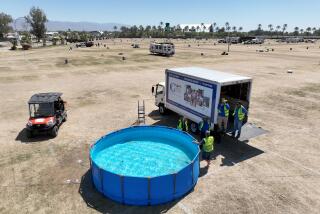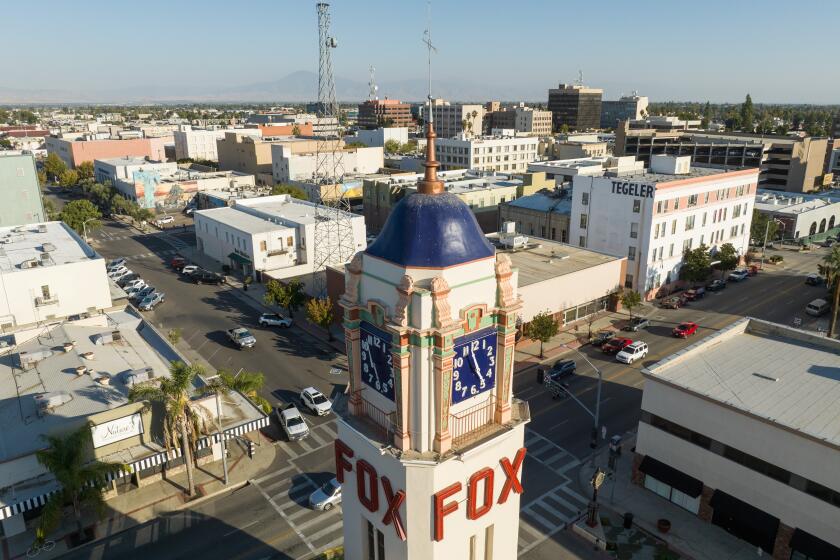Norwalk Area Deputies Put Byte on Crime : Computer Graphics Used for Deployment
Patrol officers at the Norwalk Sheriff’s Station are discovering that crime analysis can be an art--especially with the use of color-coded graphics to direct officers to high-crime areas.
Called Landtrak, the computer resembles a video game; it maps out the streets in the Norwalk station’s 40-square-mile jurisdiction in a geometric pattern of red, white and green lines, and displays the location of recent crimes in a rainbow of colored dots.
The computer is an electronic version of the traditional pin map that most stations use to keep a visual record of local crimes. But with its direct access to an electronic data base of police information, Landtrak can display crime patterns and find the residences of recent felons, allowing patrol officers to concentrate on high-crime areas and detect links between crime sprees and career criminals. It also helps free some personnel from paper work.
Unique System
While police departments in San Jose, Oxnard and San Diego have already installed systems that can take bits of information about a crime and help connect them with known offenders, Norwalk is the only station to combine such a data base with a graphics computer.
“With the graphics, we are taking computer crime analysis one step further and using it for patrol deployment,” said Sgt. Bill Miller of the Norwalk Sheriff’s Crime Analysis Unit, who designed the system along with his partner, Sgt. Jim Morrow.
The Norwalk system is the newest addition in the statewide Career Criminal Apprehension Program, which was begun in 1975 by the Office of Criminal Justice Planning to focus crime-fighting efforts on catching repeat offenders. With Californians voting to decrease government spending, the office decided to pump funds into new computer systems that would increase the efficiency of existing police forces without the need for hiring more officers. To date, the office has given $12.2 million to 50 police agencies.
In 1983, Miller arranged for the Norwalk station to receive a $515,000 grant. “We wanted to have ‘directed patrol’--that is, directing your resources during those off-times (when there is little activity) to the areas of potential crime,” he said. “With these visuals we can direct our officers to the problems and let them come up with the solutions.”
Pinpointing Crime Sites
Landtrak can locate any number of major crimes that have occurred in the area, each in a different color, and can zoom in on a portion of the map to identify street names and addresses. It can also locate crimes according to the day of the week or time of day they occurred.
By using the information in the continually updated data base, the computer can identify the residences of recent offenders and known gang members. It also provides a detailed description of the person, his crimes and his methods of operation.
Printouts of the map are given to patrol officers, who use them on their beats. If the officer notices an unusual cluster of dots on the map he can concentrate his efforts in that neighborhood, looking for any connection between the crimes and felons who live in the vicinity.
Although the Norwalk system has been used for patrol deployment only since the beginning of the month, Miller says it has already paid off.
Officers saw a pattern of dots developing near two shopping centers where there had been a number of robberies on weekend nights. “So we focused our patrolling in that area during the same time of the week, and we caught the guy right away,” Miller said.
Recently Out of Prison
Sheriff’s investigators connected the thief with 23 burglaries in the area and found that he had been released from prison six months earlier. The man pleaded guilty to one count of burglary.
Miller said that the new electronic system has led to a decrease in time-consuming clerical work, already freeing one sergeant from paper-work duties and allowing him to return to leading a detective team.
“We let the computer do the paper work for him now,” Miller said.
The new crime-solving technology has its skeptics, however.
Jay BloomBecker, director of the National Center for Computer Crime Data in Los Angeles and a former Los Angeles County deputy district attorney, says that too often computers are not used effectively in crime solving because investigating officers do not understand how to apply the technology to their work.
He added that there is also the potential for civil rights violations in using a computer to link crimes with former criminals.
“The intelligence implications are enormous--and dangerous,” he said. “How far do you go before the (suspect’s) rights are violated?”
Miller is aware of the potential for abuse and says his department regularly purges unnecessary information. And he points out other uses for the computer.
Emergency Preparation
Within a year, the computer will be able to display the routes of underground pipelines and the contents of all storage tanks at nearby refineries in case of leaks or explosions. Plans are also in the works to add diagrams of certain “high risk” robbery locations, such as bars and liquor stores, which would show interior layouts, allowing officers to respond more effectively to robbery calls.
Following the example set by Norwalk, both the Carson and Industry sheriff’s stations have received grants and are in the process of coming up with similar data base and graphics systems.
“It’s kind of nice to be first with something,” Miller said. “Police are usually 20 years behind everyone else when it comes to new technology.”
More to Read
Start your day right
Sign up for Essential California for news, features and recommendations from the L.A. Times and beyond in your inbox six days a week.
You may occasionally receive promotional content from the Los Angeles Times.






